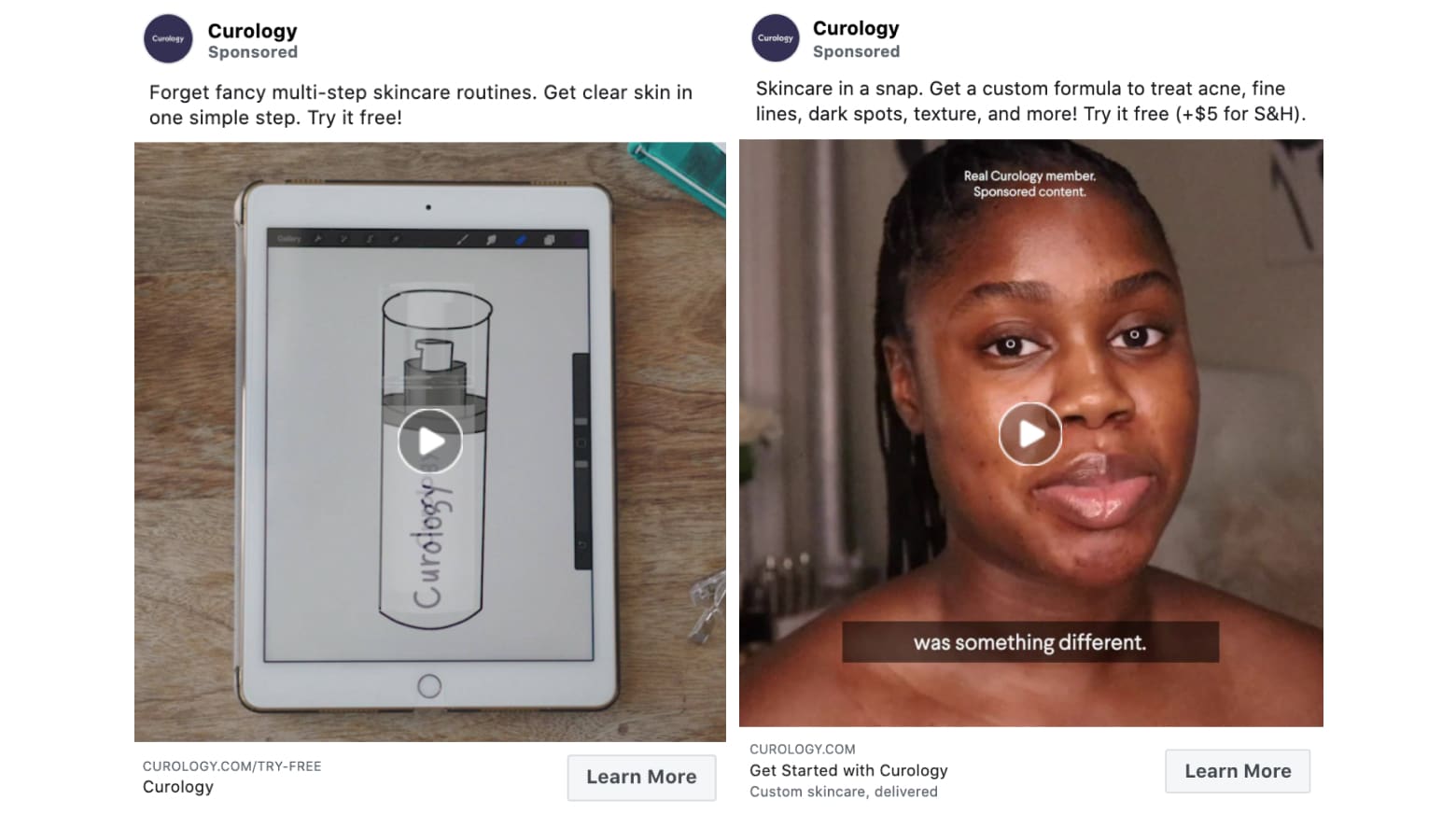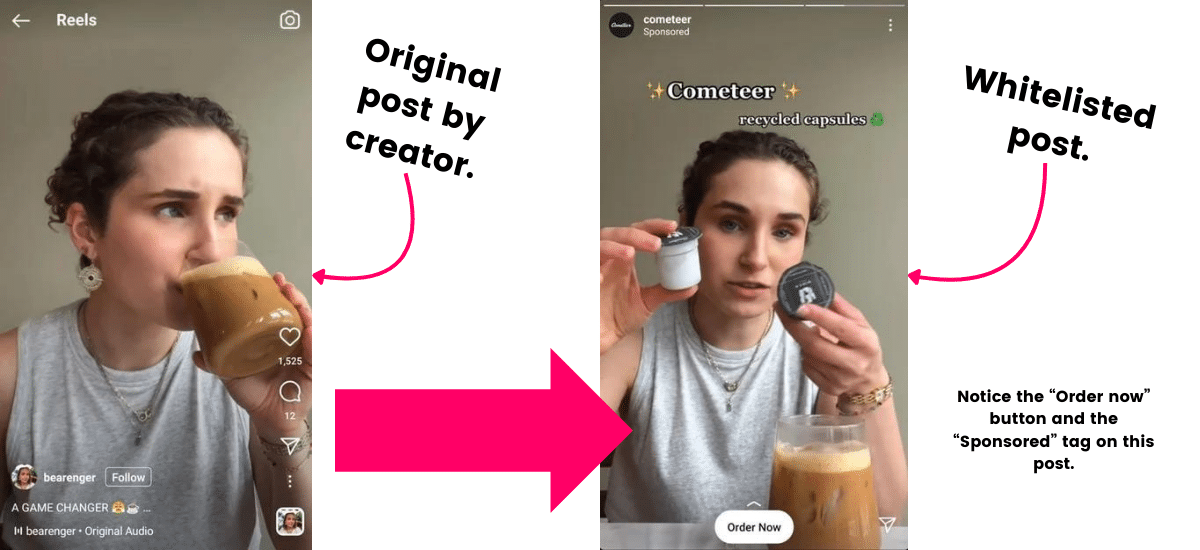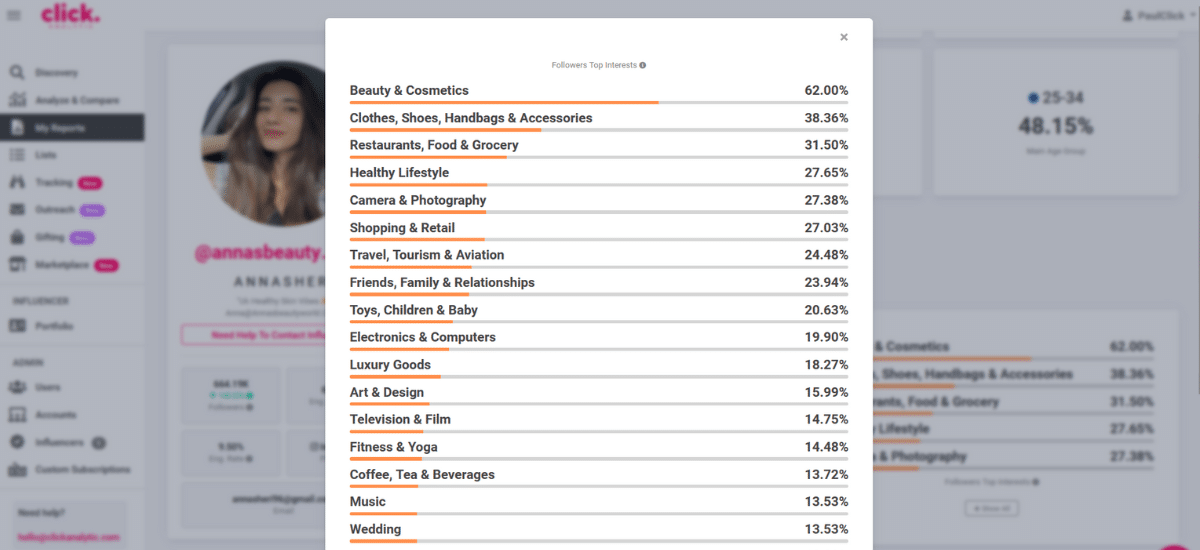What is whitelisting in social media?
So, you’re wondering, “What is whitelisting in social media?”
💡 The textbook answer is this: Whitelisting in social media is when an influencer grants a brand permission to run ads through their account.
Marketers are saying that influencer whitelisting can increase conversion on ads by 30% vs. traditional ads and lower the cost of acquisition by 70%!
👉 Because this strategy amplifies the reach of your campaigns while integrating seamlessly into users’ feeds. It enhances authenticity and engagement.
But there’s more. Join me as I explain:
👉 how whitelisting differs from brand-owned ads,
👉 what types of creators and content to whitelist,
👉 and the steps to get started.
Plus, I’ll highlight the numerous benefits of this powerful marketing tool.
Ready to elevate your influencer marketing game? Let’s roll! 👇
What is social media whitelisting?
Social media whitelisting is when an influencer allows a brand to use their social media account for ads.
Simple, right? Let’s look at some examples of social media whitelisting.
How is a whitelisted social media ad different from a brand-owned ad?
Whitelisted ads run through an influencer’s account, while brand-owned ads run through the brand’s handle. Let me break it down for you:
When you think of influencer marketing, those #sponsored posts on personal accounts probably come to mind.
You’ve seen them – “Paid partnership with [Brand]” on Instagram, or “[Creator] with [Brand]” on Facebook.
These posts are often turned into brand-owned ads, running under the brand’s handle. Take Curology, for example.
They worked with influencers who shared their acne journeys in videos, and Curology repurposed these into brand-owned ads on Facebook. This strategy humanises the brand and adds social proof from real users.

But here’s where whitelisting steps it up a notch.
Whitelisting lets brands run ads directly through the influencer’s account. So, the ad shows up as if the influencer is posting it themselves.
Brands can tweak the ad slightly for better performance – adding “Shop now” buttons, changing the copy, or editing the content a bit.
Take a look at how Cometeer used a whitelisted creator video for their Reels campaign.

The ad content mirrors the creator’s original Reel perfectly, yet there’s no “Paid partnership” label or direct mention of the creator.
Plus, they can create dark posts – paid ads that don’t clutter the influencer’s timeline but still reach the targeted audience.
Another cool feature?
👉 Whitelisting lets brands tap into the influencer’s audience data. They can create lookalike audiences, targeting people similar to the influencer’s followers, not just their current audience.
💡 My pro tip: Grab this free trial of my favourite influencer marketing platform and quickly find looklikes for your brand.
But there’s more.
Typically with a sponsored post you can reach up to 30 – 40% of an influencer audience due to the algorithm of social media platforms.
But with whitelisting you can reach 100% and also expand to lookalike audiences! 🤯
And it gets better.
With whitelisted social media content, brands can add UTM parameters to call-to-action buttons and IG Story swipe-ups in dark posts, gaining full visibility in Google Analytics.
The result?
Brands can clearly measure the ROI of their influencer campaigns, whether they’re aiming for reach, page views, or sales.
💡 My pro tip: Don’t forget about the other ways to work with influencers. You must also use sponsored content and UCG content to truly drive engagement.
In my opinion, whitelisted ads offer more control, better targeting, and precise tracking, making them a powerful tool for brands to achieve their marketing goals.
Sadly, you can’t whitelist any creator’s content. Let me explain. 👇
What type of creators should you whitelist?
To power your ad campaigns with top-notch content, whitelisting the right influencers is key.
First, look for influencers who produce creative and authentic content.
You want their posts to blend seamlessly into consumers’ feeds while staying true to your brand.
Remember, the best ads don’t even feel like ads – they’re just part of the flow.
Next, spend time vetting influencers. Check their audience data thoroughly.
You need influencers whose followers match your target demographic. This ensures you can build accurate lookalike audiences and reach potential new customers effectively.
Look at this example:

Here, you can see that 62% of Anna Sheri’s audience is interested in cosmetics and beauty. That’s why top brands like Dove, L’Oréal Paris and Estee Lauder work with her.
Here’s another tip. 👇
Always choose influencers whose content feels genuine and whose audience aligns with your brand’s goals. This way, your whitelisted ads will resonate more and drive better results.
Now, what about the content type? 🤔
What type of content should you promote as whitelisted ads?
No need to reinvent the wheel. Whitelisted ads should target an audience similar to your brand’s existing community.
Start with a content strategy that’s already proven successful. This way, you’re serving content that’s likely to resonate with your target audience.
At Click Anlytic, I’m all about the test-and-invest method. Testing different content types helps you discover what really clicks with your audience.
Here are some factors to consider when testing:
⚙️ Influencer niche: Different influencers connect differently with your audience. For instance, fashion-focused creators might engage your audience better than general lifestyle influencers.
⚙️ Aesthetic: Try different styles. Your audience might prefer bold, flashy colours over a minimalist look. Collaborate with creators who offer a variety of aesthetics to see what garners the most engagement.
⚙️ Creative type: Mix it up with still images, Instagram carousels, Stories, and videos. Different formats can drive different levels of engagement.
⚙️ Copy: The optimal copy length can vary. The shorter, punchier copy might work best for fast-moving Instagram Stories. Experiment with long captions, short captions, and headlines to find the sweet spot.
⚙️ CTA (Call-to-Action): Test different CTA buttons to see which gets the most clicks. Does “Shop now” outperform “Learn more”?
By testing these elements, you can refine your strategy and find the content that drives the best results.
As for the benefits of social media whitelisting, you’re in for a surprise!
Benefits of social media whitelisting
Social media whitelisting offers a range of benefits for both brands and influencers. Here’s a quick rundown:
🎯 Enhanced targeting:
Whitelisted ads allow brands to precisely target specific audiences, including those who don’t already follow the influencer. This means your ads reach more potential customers who fit your ideal demographic.
🎯 Creative control:
Brands can make small edits to the influencer’s content, such as tweaking the copy, adding call-to-action buttons, or adjusting the visuals. This helps optimise the ads for better performance without losing the influencer’s authentic touch.
🎯 Extended reach and longevity:
Unlike typical posts with a short lifespan, especially on platforms like Instagram Stories, whitelisted ads can be shown longer. This ensures your content stays visible and continues to attract engagement over time.
🎯 Cost efficiency:
By integrating whitelisting into your collaboration terms, you maximise the value of your influencer partnerships. This can lower your customer acquisition costs (CAC) and boost your return on ad spend (ROAS).
🎯 Access to performance metrics:
Both brands and influencers gain access to detailed performance metrics. Brands can analyse the effectiveness of their campaigns, while influencers get insights into what type of content resonates best with their audience.
🎯 Authenticity and trust:
Running ads through an influencer’s account lends authenticity to the content, making it feel less like a traditional ad and more like a trusted recommendation. This builds trust with the audience and enhances the credibility of the brand.
🎯 Seamless integration:
Whitelisted content blends naturally into users’ feeds, making it more likely to be viewed and engaged with. The seamless integration of these ads ensures they don’t disrupt the user experience.
🎯 Versatile ad formats:
Brands can experiment with various ad formats, from still images and carousels to videos and Stories. This flexibility allows for creative experimentation to see what works best.
In summary, social media whitelisting is a powerful tool that enhances targeting, creative control, and cost efficiency while building trust and authenticity.
See why I call it a win-win strategy? It can significantly boost the impact of your influencer marketing campaigns.
Are you ready to get started with whitelisting in social media?
My final thoughts
Now that you have the answer to “What is whitelisting in social media?” What’s your next step? You can use an influencer marketing platform to quickly find the perfect influencer for your next campaign.



